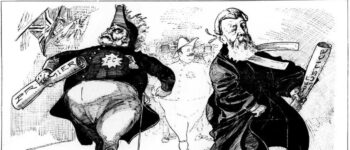1898: Getting Rid of Robert and Anna Stout
November 18, 2022
By AHNZ
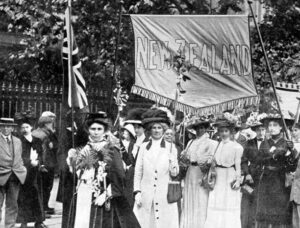 Today in New Zealand history, 19 November, 1909, a letter was published in the London Times by Anna Stout (image left, holding Union Jack.) Stout, along with husband Robert, and sometime Prime Minister and Chief Justice, were left-wing politicians. She was active alongside Kate Sheppard and other wealthy social justice warriors in the Women’s Christian Temperance movement and its side-quest to reinstate¹ voting rights for women in general elections. However, Anna had been put in a box since 1899 when her husband became New Zealand’s 4th Chief Justice and as such neither Stout was allowed to be involved in political public life. Separation of Powers, however, did not count if you were offshore so when Robert and Anna visited England in 1909 she exploded with pent up energy! Robert returned to his duties in New Zealand but Anna stayed in Britain where she could vent. Ref. 1909: Anna Stout’s Reasons
Today in New Zealand history, 19 November, 1909, a letter was published in the London Times by Anna Stout (image left, holding Union Jack.) Stout, along with husband Robert, and sometime Prime Minister and Chief Justice, were left-wing politicians. She was active alongside Kate Sheppard and other wealthy social justice warriors in the Women’s Christian Temperance movement and its side-quest to reinstate¹ voting rights for women in general elections. However, Anna had been put in a box since 1899 when her husband became New Zealand’s 4th Chief Justice and as such neither Stout was allowed to be involved in political public life. Separation of Powers, however, did not count if you were offshore so when Robert and Anna visited England in 1909 she exploded with pent up energy! Robert returned to his duties in New Zealand but Anna stayed in Britain where she could vent. Ref. 1909: Anna Stout’s Reasons
It had been politically convenient for Robert to be a Temperance advocate in the 1870s which is also when he, 34, married Anna, 18 years old. The fashion, therefore politics, changed until the 1890s when telling Kiwis what they could and couldn’t drink became ‘progressive’ once again and Social Justice Warriors resumed domination of the mainstream. Robert did nothing about this when he had power but when seeking it he brought back his old Temperance routine as a way to contest the leadership of the Liberals against Richard Seddon after the death of John Ballance. This was a sudden move attempting to bring down Seddon’s Ministry so that the Stouts could rise again. Robert had not mentioned it in his recent buy-election² campaign but Richard Seddon met the attack with liquor controlling legislation of his own so that a duel ensued as to who the better booze bully was!
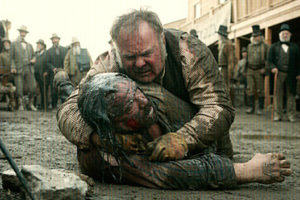 Seddon prevailed but Stout wasn’t going away so something had to be done; New Zealand’s Liberal Ministry wasn’t big enough for both big men. Yet, they battled it out in the muck for another 5 years! Stout soon left his West Coast seat to install himself in Wellington Central electorate. Until 1898 Seddon really had to watch his back and keep his nose clean so as not to give Stout an inch in the ongoing battle. New Zealand was probably better for it because the two men checked each other’s power and prevented anything too radical from occurring to us. According to one source³ the tide turned in this street fight when firms connected to Stout got into financial trouble and Seddon found this out and so had his edge. Richard Reeves had created Stout’s buy-election by resigning over such matters and Seddon’s right-hand man Joseph Ward resigned with the same problem. The exit deal that Stout took in 1898 was to become Chief Justice in mid-1899 (25 May 1899.)
Seddon prevailed but Stout wasn’t going away so something had to be done; New Zealand’s Liberal Ministry wasn’t big enough for both big men. Yet, they battled it out in the muck for another 5 years! Stout soon left his West Coast seat to install himself in Wellington Central electorate. Until 1898 Seddon really had to watch his back and keep his nose clean so as not to give Stout an inch in the ongoing battle. New Zealand was probably better for it because the two men checked each other’s power and prevented anything too radical from occurring to us. According to one source³ the tide turned in this street fight when firms connected to Stout got into financial trouble and Seddon found this out and so had his edge. Richard Reeves had created Stout’s buy-election by resigning over such matters and Seddon’s right-hand man Joseph Ward resigned with the same problem. The exit deal that Stout took in 1898 was to become Chief Justice in mid-1899 (25 May 1899.)
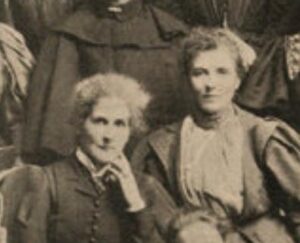 During this time Anna had agreed to accept the presidency of the National Council of Women in 1895 provided Kate Sheppard would do all the work. Instead, Sheppard became President (which lead to her being on our $10.00 note) and Anna the Vice President. Almost at once Stout had a public dispute and defected from the NCW which became defunct. Not ones to be accused of hard working, they immediately take a ‘recess period of twelve years.’ State History often records that the NCW started up on this day but frequently fails to mention that it was not the start but the end of something. A last gasp. Ref. 1896: The National Council of Women, AHNZ
During this time Anna had agreed to accept the presidency of the National Council of Women in 1895 provided Kate Sheppard would do all the work. Instead, Sheppard became President (which lead to her being on our $10.00 note) and Anna the Vice President. Almost at once Stout had a public dispute and defected from the NCW which became defunct. Not ones to be accused of hard working, they immediately take a ‘recess period of twelve years.’ State History often records that the NCW started up on this day but frequently fails to mention that it was not the start but the end of something. A last gasp. Ref. 1896: The National Council of Women, AHNZ
Now Mr and Mrs Chief Justice, the Stouts could now settle into their new high position and Seddon was left to Govern. Most importantly, a Chief Justice does not express or involve himself with political involvement and neither does his wife. For Seddon, and anyone who had had enough of both Robert and Anna Stout, it was a two-for-one deal to hush them up by ‘kicking them upstairs.’ I would love to know how Anna Stout responded to this trade because she had to become apolitical too now but still had plenty of steam. It would have to wait
“Old political powerhouses, Robert and Anna Stout, were outside the halls of power when Prime Minister John Ballance died in 1893. Well that makes it pretty hard to contest the leadership of the Liberals so Richard Seddon grabbed it. Later in the same year the Inangahua buy-election was Stout’s chance to get back in, which he did. Next, in order to crash Seddon’s Ministry the ploy was used to bring back the old anti-alcohol card. Stout and Seddon battled it out between them to push and pull New Zealand into alcohol control laws as shown in this contemporary cartoon, (Te)Total Immersion. It had zip to do with what was good for the country. Really a political bidding war between two contenders who wanted to be in charge. This was finally settled when Stout was gagged and ‘paid off’ by being given the position of Chief Justice. I would love to know how Anna Stout responded to this trade because she had to become apolitical too now but still had plenty of steam. It would have to wait.” – AHNZ, Facebook (2022)
“Stout had long believed in temperance. Suddenly, without warning even during his recent election campaign, he assumed the role of parliamentary leader of the prohibitionists. He had not pressed the reform of liquor licensing when he was Premier, and it seems fair to agree with Seddon that he took up the issue in order to embarrass (or wreck) the Government.” – p178, Sinclair (1965)
“This entailed bossy Women’s Christian Temperance Union banging on about vice and trying hard to force prohibition upon everyone. New Zealand was flooded with prohibition tracts, novels, reciters, prayer-books. Our two main contenders for Prime Minister, Richard Seddon and Robert Stout dueled it out over who had the more popular liquor-licencing law. The oppression had become great, toxic even, and people were looking for a relief and a change.” – 1890: The Students of Truth, AHNZ
“The Salvation Army inherited, took over, and militarised the Temperance Movement that once belonged to women like Shepherd and Anna Stout.” – 1899: A General Inspection, AHNZ
“Stout remained in the Liberal Party, but constantly voiced objections to Seddon’s leadership. In addition to claiming that Seddon was betraying Ballance’s original progressive ideals, Stout also claimed that Seddon was too autocratic in his style of rule. Ballance’s idea of a united progressive front, Stout believed, had been subverted into nothing more than a vehicle for the conservative Seddon. Seddon defended himself against these charges by claiming that Stout was merely bitter about not gaining the leadership.” – Wiki
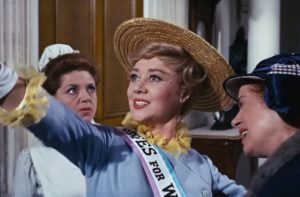 Anna Stout’s next chance to have an independent voice in social or political matters came during a family trip to England in 1909. That’s 11 years into being Mr and Mrs Chief Justice with another 17 years to go! Robert returned to his duties in New Zealand in 1910 but Anna preferred the liberty of exile because she could once again mix and have a voice with agitators and campaigners. Freed from the constraints of her New Zealand role, while still enjoying its status, Anna Stout “aligned herself with the WSPU, the militant wing of British suffragism founded by Emmeline and Christabel Pankhurst” (ref. p141, The Suffragists (1993.)) This was the same association that Feminist/Socialist Emily Davison was already a member of and who would make herself famous for the cause by hunger strikes, arrests, bombings, arson, and by committing suicide by putting herself in the way of the King’s horse at the 1913 Epsom Derby.
Anna Stout’s next chance to have an independent voice in social or political matters came during a family trip to England in 1909. That’s 11 years into being Mr and Mrs Chief Justice with another 17 years to go! Robert returned to his duties in New Zealand in 1910 but Anna preferred the liberty of exile because she could once again mix and have a voice with agitators and campaigners. Freed from the constraints of her New Zealand role, while still enjoying its status, Anna Stout “aligned herself with the WSPU, the militant wing of British suffragism founded by Emmeline and Christabel Pankhurst” (ref. p141, The Suffragists (1993.)) This was the same association that Feminist/Socialist Emily Davison was already a member of and who would make herself famous for the cause by hunger strikes, arrests, bombings, arson, and by committing suicide by putting herself in the way of the King’s horse at the 1913 Epsom Derby.
London was liberating for Anna, able once more to be controversial and march through the streets and speak from platforms. She did not go home to Wellington until 1912 and I wonder if the unsuccessful and increasingly violent Suffragettes drove her away?⁴ After the British burst of energy Anna came back into ‘exile’ in Wellington now in her 50s. She mostly worked behind the scenes, still for women’s causes. However, she did stick her neck out in 1918 and 1922 for sex workers. However, the torch of telling people what to do with their bodies when it came to drink had now passed to other Socialist-Religious sects such as the Salvation Army and Bessie Lee-Cowie. Robert died in 1930, Anna in 1931.
—
1 Women could and did vote in local elections. They also voted in general elections but this was taken away for a couple of terms before Kate and Anna ‘won’ it back. Ref. 1934: Death of Kate Sheppard, AHNZ
2 Yes, that’s the deliberate AHNZ spelling of ‘by-election’. Curious that this Inangahua buy election occurred on 8 June, 1893, when the General Election was on 28 November of the same year. Premier Seddon would not have wanted that but Stout was clearly the superior string-puller probably based on access legalistic tricks. Stout’s ambition also relied upon the incumbent for that West Coast seat, Richard Reeves, very conveniently becoming bankrupt and so having to resign his seat. Suspiciously lucky and in the nick of time for Stout?
3 Kelburn, King Dick and the Kelly Gang: Richard Seddon and Political Patronage, Kevin Bourke (2008); Wiki
4 From 1912 Anna’s Suffragette friends became madwomen. Ref. Suffragette bombing and arson campaign, Wiki
Image ref. Stout and others taking the women’s suffrage fight to England in 1910; Auckland Weekly News, Auckland War Memorial Museum; nzhistory.govt.nz
Image ref. A way out of the difficulty. William Blomfield, New Zealand Observer, (18 July 1903); Alexander Turnbull Library
Image ref. Street fight, Deadwood (2004)
Image ref. Anna and Kate just before the big NCW blow-up of 1896. Zoomed in. Alexander Turnbull Library
Image ref. Same image, zoomed in on Anna and Kate
Ref. William Pember Reeves New Zealand Fabian, Sinclair (1965)
 Like Comment Share
Like Comment Share

